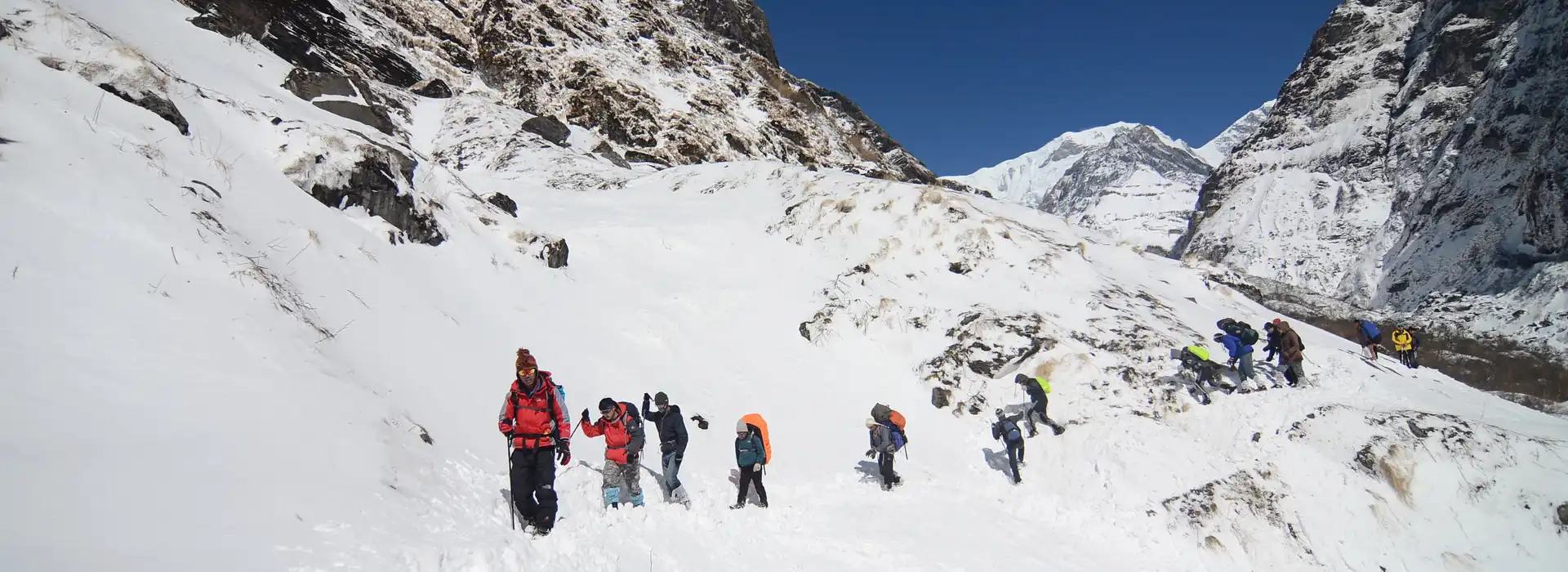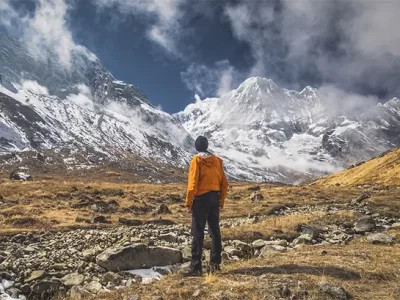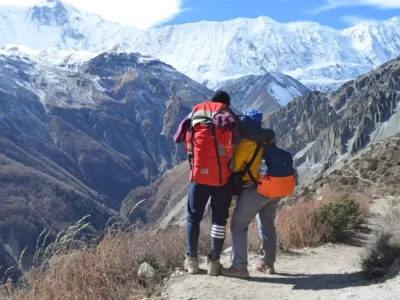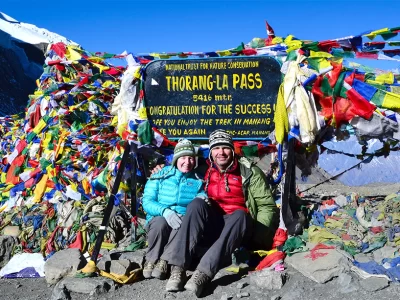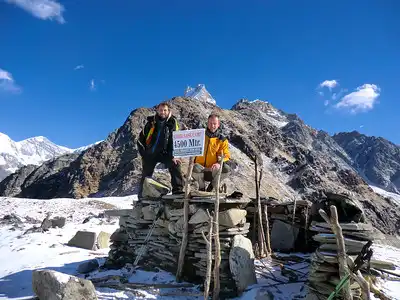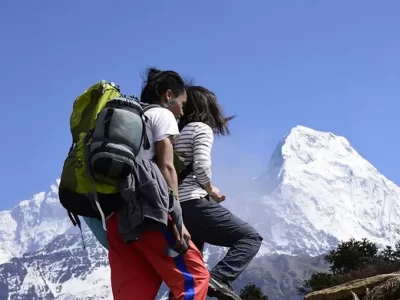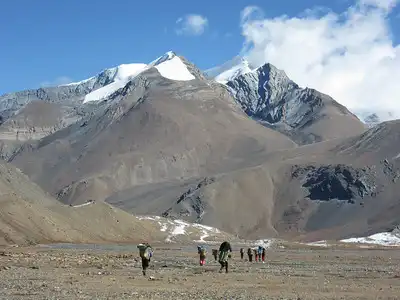Located in the Annapurna ranges, which are among the major peaks on the planet, the Annapurna Base Camp trek, often abbreviated as ABC, is one of the most sought-after adventures globally. They are, however, guided through the key routes within the heart of Annapurna Himalayas, with its major highlights being the most amazing sceneries in the world.
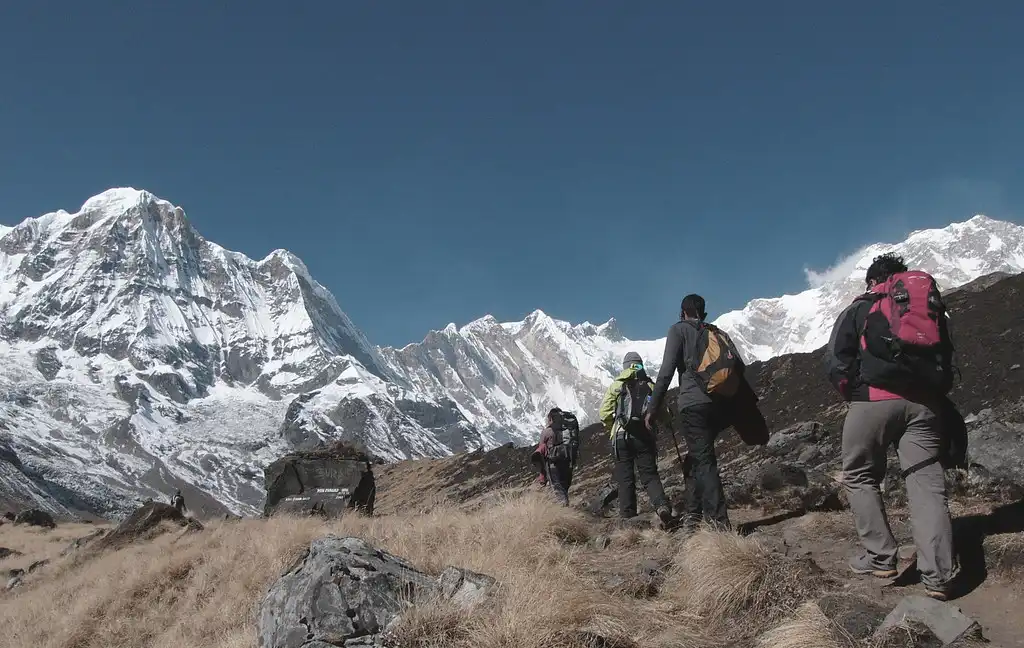
Trekkers find it helpful and very informative through its detailed insights and advice given on how best they can easily move along this breathtaking path by the Annapurna Base Camp Trekking Guide.
Highlights
- Pokhara Entry Point: Begin your adventure at Pokhara, the lakefront tourism capital of Nepal.
- Natural Wonders: Navigate through landscapes dotted with cascading waterfalls, lush rhododendron forests, and serene bamboo groves.
- Flora and Fauna: Discover the rich biodiversity that turns this trek into a nature lover’s paradise.
- Cultural Immersion: Meet and learn from the Gurung and Magar communities about their rich cultures.
- Architectural Delights: Explore traditional architecture and ancient inscriptions throughout your trek.
- Poon Hill Panorama: Climb Poon Hill to witness a spectacular sunrise and panoramic views of the mountains.
- Landscape Diversity: Appreciate the unique combination of majestic high mountains and picturesque low hills.
- Abundant Accommodation: Find comfort in various guesthouses, lodges, and teahouses, where locals extend warm hospitality.
- Jhinu Danda Hot Spring: Soothe your muscles in the hot springs at Jhinu Danda, which is a perfect way to wind down after the trek.
Annually, thousands of hikers go there because it has a perfect blend of nature’s goodness, culture, and challenging trails. The place gains importance among those who love adventure. On the way to Annapurna Base Camp (ABC), surrounded by the fantastic Annapurna Himal peaks, you will encounter a number of different types of landscapes, from luxurious rhododendron forests all through stark alpine meadows. Still, it would help if you also considered factors that influence its price, including choice of path and duration of trip, among others.
Going to Annapurna Base Camp typically involves not just a physical challenge but also interaction with the surrounding area, including its people and customs, so trekking to Annapurna is about more than just taking a walk here. Annapurna Base Camp is a term that does not simply denote a place in terms of space coordinates but signifies something meaningful for the world of high-altitude trekking—thus, many trekkers aspire to get there.
Annapurna Base Camp Trek
Annapurna Circuit Trek
Mini Annapurna Circuit Trek
Pre-Trek Preparation
Best Time to Visit
Spring Season: A trek to the Annapurna Base Camp during the spring months from March to June presents a unique and exhilarating experience in the Nepalese Himalayas. The spring season is widely recognized as the optimal time to undertake the Annapurna Base Camp Trek for several compelling reasons.
In spring, the climatic conditions in the Annapurna region are ideal. The days are pleasantly warm, providing trekkers the opportunity to savor the breathtaking vistas without the harshness of severe cold. Nevertheless, it’s important to gear up for cool evenings as nighttime temperatures can plummet to as low as -8 degrees Celsius.
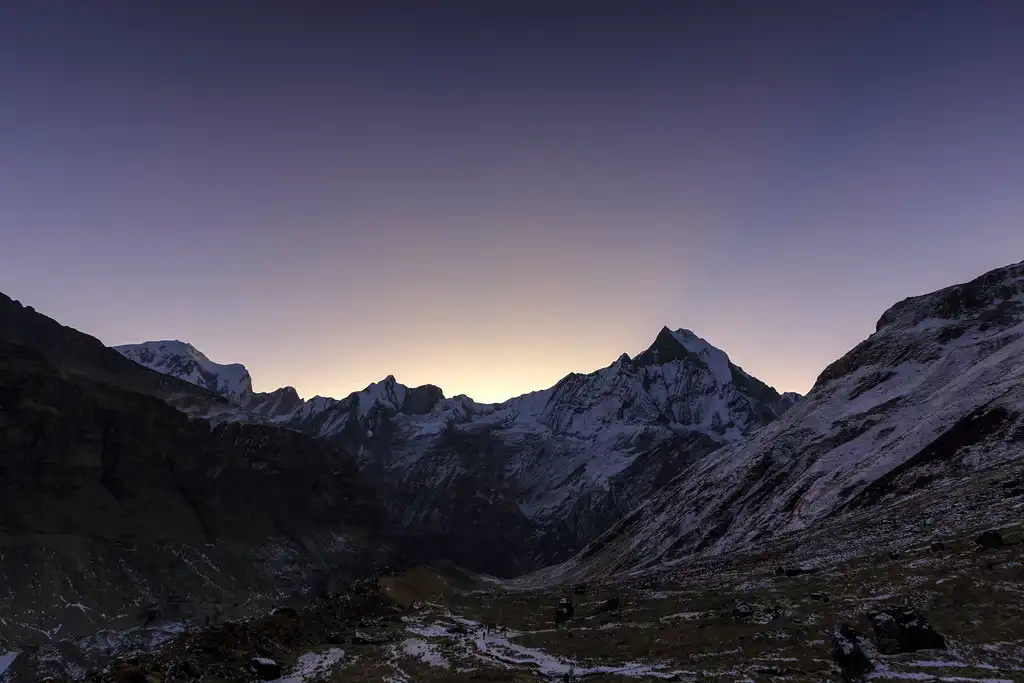
A captivating feature of the spring trek is the dramatic transformation of the landscape. Lush greenery bursts forth in the forests, and blooming rhododendrons and magnolias dot the trails with bright colors.
It is essential to pack suitable apparel and gear, including multiple layers to combat the cool nights and sun protection for the daytime. A standout experience during this trek is observing the enchanting sunrise from the Annapurna Base Camp. The sight of early morning sunlight bathing the snow-capped peaks in a golden light is truly mesmerizing, offering a moment that many trekkers hold dear.
Another great benefit of spring trekking is the temperate weather, which is neither too hot nor too cold, providing stable conditions with minimal rainfall. The trails remain dry, reducing the risk of slips and falls, thus enhancing the safety and enjoyment of the trek. Overall, a spring trek to the Annapurna Base Camp is an extraordinary adventure where nature’s beauty is showcased in full splendor, offering an immersive Himalayan experience.
Summer/Monsoon Season: Venturing into the Annapurna Base Camp during the summer and monsoon months from July to mid-September offers a unique trekking experience in Nepal. At this time, Nepal’s weather transitions to its monsoon and summer phases. Daytime temperatures in the Annapurna Region hover around 20 to 25 degrees Celsius, creating an invitingly warm atmosphere for trekkers.
Nighttime, however, can still see temperatures falling to between -1 and -2 degrees Celsius, necessitating warm clothing for colder evenings. The monsoon period introduces particular challenges, notably sponges, which are prevalent in damp conditions. Travelers should remain alert and employ preventative measures to avoid leech bites.
The season may also bring landslides, which can alter routes and demand flexibility from trekkers. Following a rain shower, the scenery of the Annapurna range is spectacularly clear. The refreshed, rain-drenched greenery enhances the visual appeal, and the air turns crisp and refreshing.
Travelers should also consider the potential for flight disruptions due to heavy rains and low visibility, which can affect travel plans. Allowing extra time in your schedule can mitigate these disruptions. A summer or monsoon trek to the Annapurna Base Camp unveils a different facet of the region, blending challenges like leeches and possible landslides with the reward of witnessing the Himalayas’ dramatic, post-rain beauty.
For those well-equipped and adaptable, this season promises a unique and enriching trekking experience.
Autumn Season: The Annapurna Base Camp Trek during the autumn months from late September to November is considered the premier time for this iconic trek. This season precedes winter in Nepal and delivers some of the most stable and favorable trekking conditions. Moderate temperatures characterize autumn, providing warmth during the day and cooler mornings and evenings, perfect for hiking.
The post-monsoon climate offers exceptional clarity and crispness in the air, thanks to the preceding rains, affording trekkers clear, unobstructed views of the Annapurna range. The path to Annapurna is often fragrant with the scent of blooming flowers, enhancing the sensory experience of the trek. Daytime temperatures typically range from a comfortable 12 to 20 degrees Celsius, while nights can cool down to between -3 and -4 degrees Celsius, so preparation for colder evenings is essential.
Teahouses along the route become vibrant meeting spots, offering chances for cultural exchange and camaraderie among trekkers. Moreover, autumn aligns with significant Nepalese festivals like Dashain and Tihar, providing trekkers with an opportunity to immerse themselves in local celebrations and deepen their understanding of Nepal’s cultural and traditional heritage.
In summary, the autumn trek to Annapurna Base Camp is an exceptional experience, blending perfect trekking conditions with cultural richness, ensuring a memorable trek for all who undertake it.
Winter Season: The Annapurna Base Camp Trek during the winter months of December, January, and February presents a formidable challenge that appeals to adventurous spirits. In winter, the ABC trail is engulfed by harsh weather conditions and adorned with a stark, snowy vista. A notable benefit of winter trekking is the decreased crowd density, which offers a tranquil experience amidst the stark beauty of the Himalayas.
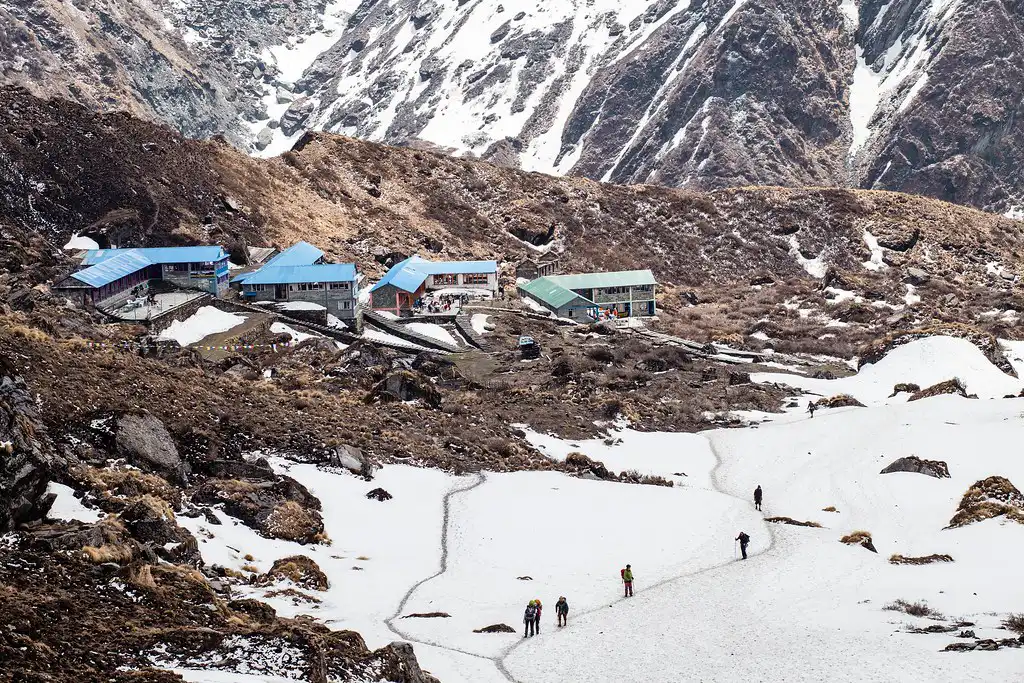
Daytime temperatures in the Annapurna region during winter hover between a frigid 0 to 5 degrees Celsius, and at night, they can plunge to between -10 and -15 degrees Celsius. The intense cold presents a substantial challenge, emphasizing the importance of adequate warmth.
However, the winter landscape is undeniably breathtaking, showcasing a serene, snow-laden environment, glaciers, snow-capped peaks, and unique wildlife and flora that thrive in cold conditions. To combat the severe cold, trekkers must equip themselves with heavy, insulating clothing and ensure they remain well-hydrated to maintain optimal bodily functions in freezing temperatures. Careful footing is crucial to avoid slips and potential injuries.
The Annapurna Base Camp Trek during the winter is a rigorous and thrilling endeavor suited only to those with considerable experience and preparedness for extreme conditions. While the snowy scenery provides a spectacular backdrop, it is vital to approach this season with a focus on safety and a clear understanding of the significant challenges and risks involved.
Mardi Himal Trek
Ghorepani Poon Hill Trek
Dhaulagiri Trek
Annapurna Base Camp Trekking Guide for Essential Gear and Supplies
Clothing and Footwear Recommendations
Pack versatile clothing for the Annapurna Base Camp Trek to handle varied temperatures and conditions. Include the following key items:
Base Layers: Choose moisture-wicking materials to keep sweat off your body.
Insulation Layers: Wear fleece or wool sweaters and jackets for essential warmth.
Outer Layer: Carry a waterproof and windproof jacket for protection against wind and rain.
Trekking Pants and Shorts: Opt for convertible and waterproof varieties.
Footwear: To avoid blisters, choose hiking boots that are strong, waterproof, and provide adequate ankle support. Could you make sure to break them in before the walk?
Socks: Bring woolen or synthetic socks to keep your feet warm and dry, and pack extra pairs.
Headgear: Include a warm hat for cold nights and a sunhat for sunny days, along with UV-protection sunglasses.
Necessary Gear
Backpack: Use a comfortable, purpose-specific backpack with a rain cover.
Sleeping Bag: Bring a high-quality sleeping bag rated for sub-freezing temperatures.
Trekking Poles: Use trekking poles to lessen knee impact on long descents and to maintain balance on uneven terrain.
Headlamp: Keep a headlamp handy for early starts or nighttime navigation.
Health and Safety Supplies
First Aid Kit: Arrange bandages, antiseptic, blister care supplies, analgesics, and prescription drugs in a first aid kit.
Water Purification: Carry tablets, drops, or a portable water filter to secure safe drinking water.
Sunscreen: Use sunscreen with an SPF of 50 or higher, and don’t forget sun-protective lip balm.
Insect Repellent: Bring insect repellent, especially during warmer months or in lower altitude areas.
Training and Physical Requirements
Fitness Levels Required
Expect a strenuous trek to Annapurna Base Camp, necessitating robust cardiovascular fitness and stamina. It would help if you managed hiking for 5-7 hours on consecutive days across varied and often steep terrain.
Tips for Physical Preparation and Acclimatization
Cardiovascular Training: Commit to running, cycling, and swimming several months before your trek to build endurance and lung capacity.
Strength Training: Develop leg strength with exercises like squats, lunges, and step training. Strengthen your core to manage your backpack better.
Hiking Practice: Frequently hike on varied terrain to prepare your legs and feet. Train with the backpack you will carry on the trek, progressively adding weight.
Mental Preparation: Condition your mind to handle physical challenges and discomfort, enhancing your trekking experience.
Acclimatization: Try to spend a few days at higher altitudes before the trek. Implement the ‘climb high, sleep low’ strategy during the trek by ascending to higher altitudes during the day and sleeping at lower ones.
Hydration: Ensure you drink plenty of water before and during the trek to stave off altitude sickness.
Diet: Consume a balanced diet rich in carbohydrates, proteins, and fats to sustain energy throughout long trekking days.
Permits and Documentation
Securing the required permits is an important step when planning a hike to Annapurna Base Camp. It would help if you had these permits mainly for conservation and ensuring trekkers’ safety. Here is what you need to understand:
Types of Permits Needed
Annapurna Conservation Area Permit (ACAP): All trekkers in the Annapurna region must obtain this permit. It funds conservation efforts and trail maintenance.
Trekker’s Information Management System (TIMS) Card: This card is mandatory for trekkers in Nepal’s major trekking areas. Authorities use the TIMS card to ensure trekkers’ safety, manage trekking activities sustainably, and locate trekkers in emergencies.
How and Where to Obtain the Permits
Obtaining the ACAP: Obtain the Annapurna Conservation Area Permit at the Nepal Tourism Board offices in Kathmandu or Pokhara. You can also get it at the conservation area’s entry points, but obtaining it in the cities beforehand can make it a timely delivery. Bring a copy of your passport, passport-sized photos, and a fee (the fee varies for SAARC nationals and other foreign trekkers).
Obtaining the TIMS Card: Issue the TIMS card at the Nepal Tourism Board offices in Kathmandu and Pokhara or through authorized trekking companies. Trekking agencies typically handle TIMS registration for you if you are trekking through an agency. Independent trekkers must obtain the card on their own. Provide a copy of your passport and two passport-sized photos, and pay a registration fee (the fee differs for individual trekkers and those in groups).
Additional Tips: Carry these permits with you throughout the trek, as you will need to show them at various checkpoints. In case you lose the originals, could you keep copies of your permits? Please make sure your travel insurance covers trekking activities; authorities often check this, and it is essential for your safety.
Trekking Routes and Itinerary
Day 01: Arrival in Kathmandu
Altitude: 1,400 meters (4,593 feet)
Once you arrive in Kathmandu, you will experience a warm welcome that sets you on course for an unforgettable adventure. After leaving the airport’s Immigration and Customs areas, Peregrine Treks and Tours personnel, who will be holding the passenger’s name sign, shall be present to welcome you at this airport. The same individuals will then take you to your hotel room, from where, depending on how much time one has at their disposal, they may choose whether they want to unwind inside or go out sightseeing within the town.
Day 02: Drive to Pokhara
Altitude: 823 meters (2,700 feet)
Duration: Approximately 6-7 hours drive
You will leave early for a beautiful drive to Pokhara. This route is downhill, going from the Nadhunga hills to the plains of Dhading, running along the Trishuli River up to Mugling and along the Marshyangdi River, and after that, exhibiting remarkable sceneries. At Ringdi Bazaar, you will have lunch consisting of local fish delicacies.
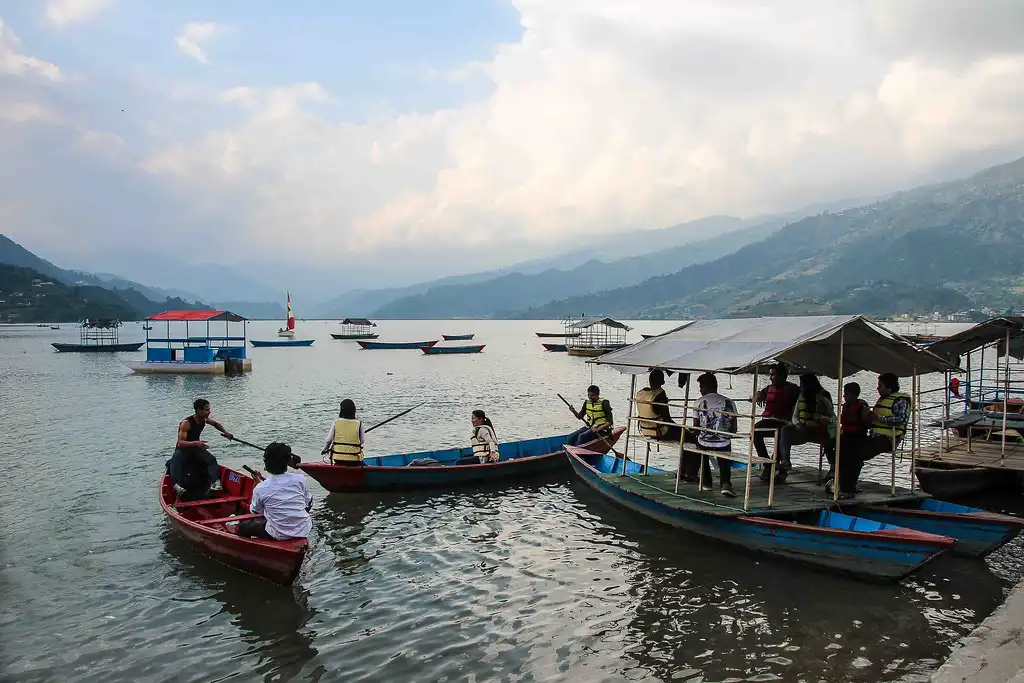
If you arrive in Pokhara at about 2 pm, then you can choose between boating on Fewa Lake or having supper at the Lakeside in town, which is always lively with tourists.
Day 03: Pokhara to Ghandruk
Altitude: 1,940 meters (6,365 feet)
You will be taken to Nayapul following breakfast from Pokhara, which is about 1.5 hours away. To begin taking your hike to Ghandruk from Nayapul, you need to have a permit check at the Birethanti settlement itself. On this particular route are green landscapes that eventually lead one into Ghandruk, a small beautiful settlement dominated by Gurungs among other ethnic people living there too.
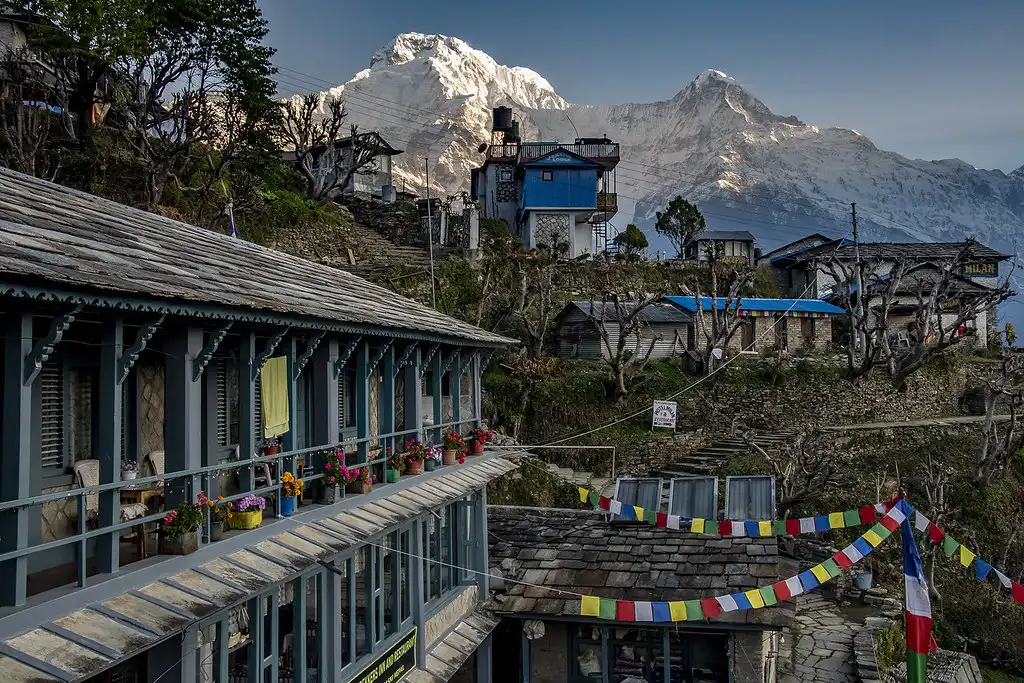
Mount Fishtail (Machhapuchhre), Mount Annapurna South, and some other peaks can be seen directly from the terrace of your hotel that you are spending a night in; thus, do not hesitate to take photos with your cameras for remembrance sake and bragging rights abroad, showing off pictures captured right from such amazing places where few individuals have ever visited before, let alone spent a night like here. If you walk a little further, there is a nice tea garden.
Day 04: Ghandruk to Chhomrong
Altitude: 2,170 meters (7,120 feet)
Duration: 5-6 hours
The trek starts with a pleasant walk to Kimrungdanda, from where there are magnificent views of Annapurna South, Machhapuchhre, Himchuli, and Gangapurna before descending to Kimo Khola valley followed by ascending steeply to Chere Danda, eventually dropping down momentarily until reaching Chhomrong located at the foothills of Annapurna range.
Day 05: Chhomrong to Bamboo
Altitude: 2,310 meters (7,579 feet)
Duration: 5-6 hours
To begin, walk down the well-known 2,500 stone steps going to Chhomrong Khola, then ascend to Sinuwa, and move through dense forest as you head to Kuldihar. Right after that, go down to Bamboo and have lunch.
Day 06: Bamboo to Deurali
Altitude: 3,230 meters (10,597 feet)
Duration: 4-5 hours
Your trek for the day passes through thick bamboo forests, and human beings will get to the Himalayan Hotel. Here, the forest clears to give way to a magnificent scene of the glacier-fed river below.
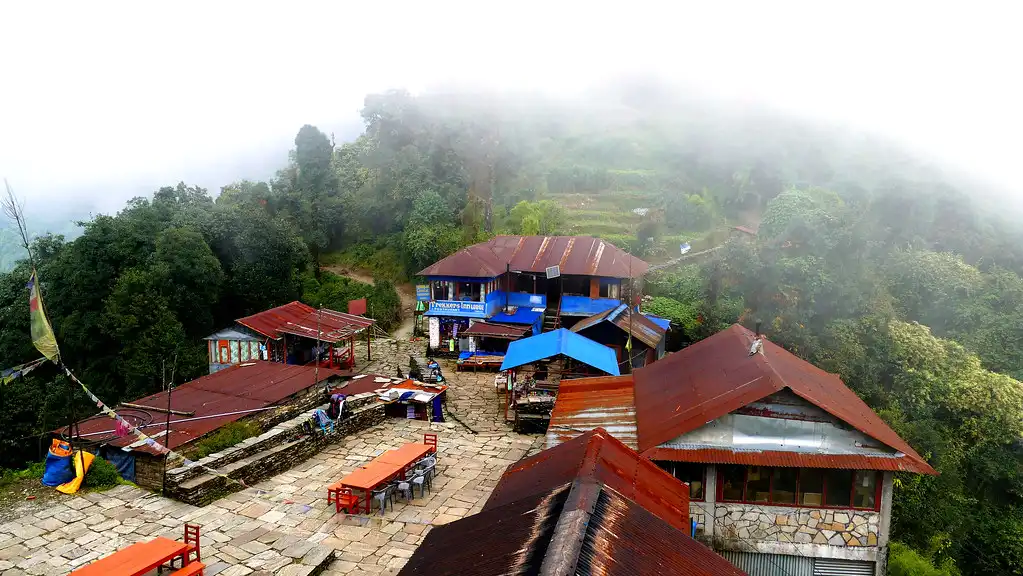
Then, continue to Hinku Cave through forested areas, descend towards the river, and rise steeply up to Deurali as you enjoy the vistas of the valley and waterfalls.
Day 07: Deurali to Annapurna Base Camp
Altitude: 4,130 meters (13,549 feet)
Duration: 5 hours
The trek from Deurali to Annapurna Base Camp is really tough, and one passes through rocky areas along the river bed before a steep climb from Bagar to Machhapuchhre Base Camp. The pay is some of the best views of the surrounding peaks. From Machhapuchhre Base Camp, you proceed to Annapurna Base Camp.
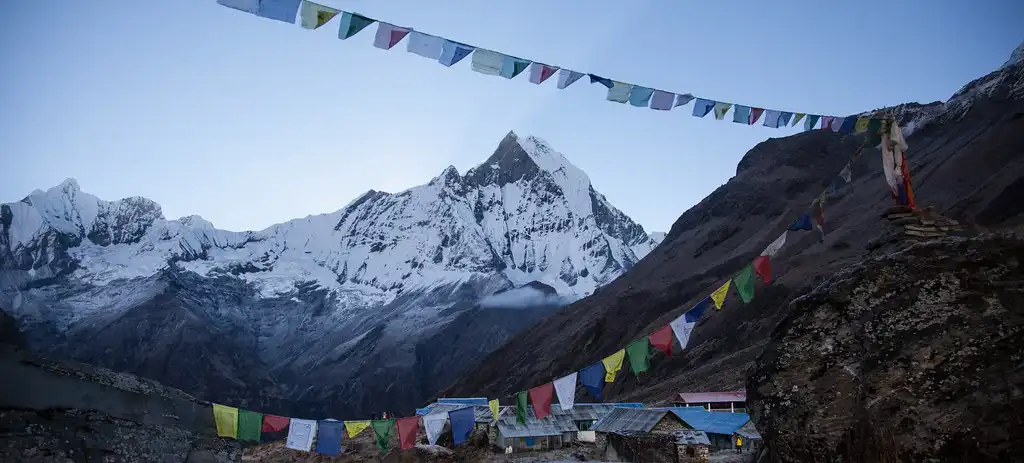
At the Annapurna Base Camp, panoramic views of Machhapuchhre, Annapurna South, Annapurna I, Annapurna III, Gandharvachuli, and Gangapurna surround you. The sanctuary offers a stunning 360-degree view of the Annapurna range, dominated by the towering south face of Annapurna I.
Day 08: Annapurna Base Camp to Bamboo
Duration: 4-5 hours
When you backtrack down the mountain from Annapurna Base Camp, return to the village of Bamboo. It will give you a new view of the same land you just passed through.
Day 09: Bamboo to Jhinu Danda
Altitude: 1,760 meters (5,774 feet)
Duration: 5-6 hours
Shift your route from Bamboo to Jhinu Danda, ascending and descending through lush forests. At Jhinu Danda, rejuvenate by soaking in the local hot springs, which are the perfect remedy for rest and recovery. They are suitable for relieving muscle tension that comes due to long walks.
Day 10: Jhinu Danda to Pothana
Altitude: 2,006 meters (6,581 feet)
Duration: 6-7 hours
Today, trek from Jhinu Danda to Pothana.The pathway will take you across Tolka village and afford you amazing sights of Annapurna South, as well as Landruk, a beautiful little village. As you trek, you will encounter a mix of rhododendron-filled jungles and terraced farmlands, showcasing the rural charm and natural diversity of the Annapurna region.
Day 11: Pothana to Nayapul, Drive Back to Pokhara
Complete your trekking by taking an effortless stroll from Pothana up to Nayapul, where you have the chance to admire the quiet charm of the hills and understand the lifestyle of the local Nepalese people. Upon reaching Nayapul, board a vehicle that will take you back to Pokhara, thus bringing your hiking adventure to an end. If the conditions of the road allow it, one can drive all the way from a point closer to Pokhara.
Day 12: Drive to Kathmandu
After breakfast at Pokhara, take a bus back home to Kathmandu. You will see the Nepalese countryside one more time during this bus ride. Once here, could you check into your hotel at about 3 pm? Use your remaining hours to relax around town or explore individualistically.
Day 13: Sightseeing in Kathmandu City
Uncover Kathmandu’s historical and cultural background during a stay at its UNESCO World Heritage sites. Among the places to visit will be ancient Swayambhunath (Monkey Temple), Bouddhanath Stupa, Pashupatinath Temple, and Kathmandu Durbar Square.
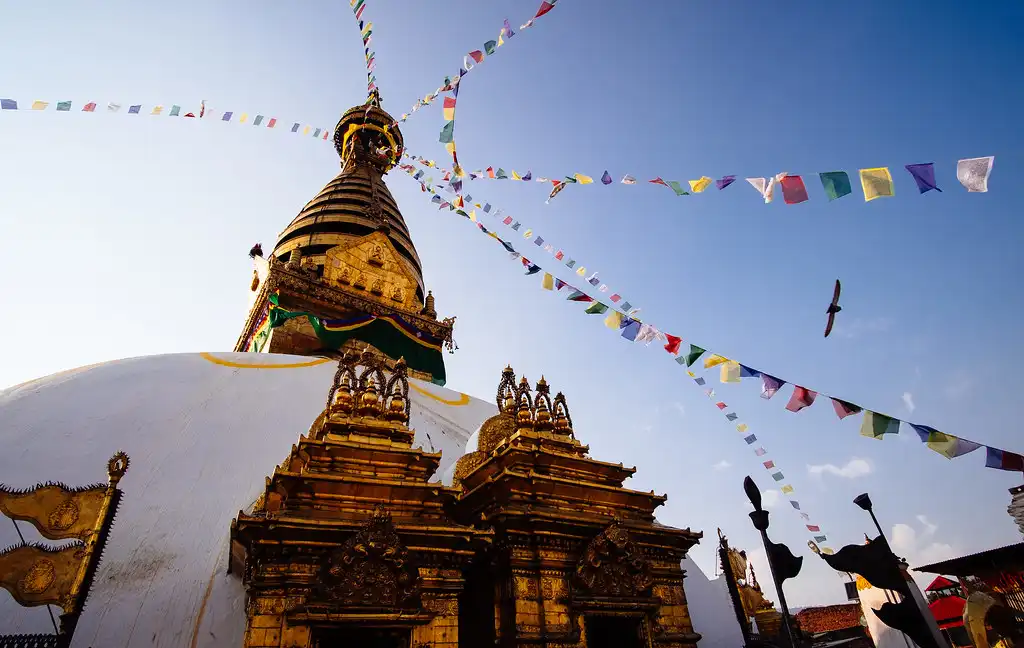
Your trek down memory lane will cap up with a traditional Nepali restaurant dinner after a short cultural presentation marking the end of the day.
Day 14: Fly Home
We will take you to the airport three hours before you are due to leave. It will mark the end of your visit to Nepal, which will leave you with memories and anecdotes to tell when you return home.
Accommodations and Meals
Peregrine Trek dedicates itself to providing outstanding lodging experiences for our guests on the ABC Trek. We provide a variety of 4-star hotels in Kathmandu and Pokhara designed for twin/double sharing.
If you would like to change your lodging preferences, we are able to accommodate these changes for an additional or reduced cost. Both Kathmandu and Pokhara offer a wide array of lodging options, from budget-friendly to luxurious accommodations.
However, options become more limited during your trekking. As you progress along the trek, you will likely stay in tea houses or local lodges. These establishments generally offer twin-sharing rooms with essential amenities. While some provide private bathrooms and hot showers, others offer shared toilets, laundry, and kitchen facilities.
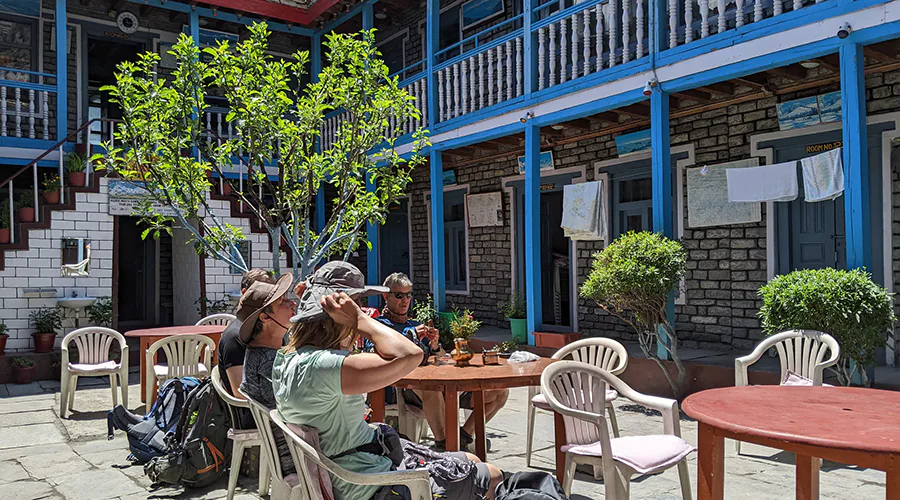
Your package includes breakfast in Kathmandu and Pokhara. For lunch and dinner, these cities offer numerous dining options. During the trek, we serve tasty breakfasts and dinners at the lodges where you stay overnight, and we provide lunch at eateries at your next destination.
Guests will have the opportunity to enjoy traditional Nepali dishes such as Daal Bhat Tarkari (Rice, Lentil Soup, and Vegetables) along with other delicious side dishes. The menu at each teahouse varies, offering items ranging from Tibetan bread and Chapati to local eggs, pancakes, soups, Sherpa stew, and momos. Additional options may include noodles, pasta, potatoes, and sandwiches.
Lodges also offer a variety of drinks, including tea, coffee, soda, and some alcoholic beverages, though the package cost does not cover these.
Challenges and Considerations
The Annapurna Base Camp Trek requires careful consideration of various challenges and precautions to ensure both a safe and respectful trek. These include managing altitude sickness, minimizing environmental impact, and respecting local customs and culture.
Altitude Sickness: Rising too rapidly to high altitudes may induce altitude sickness, also known as acute mountain sickness (AMS). Common symptoms include headaches, nausea, dizziness, fatigue, reduced appetite, and trouble sleeping. In more severe instances, it could develop into High Altitude Pulmonary Edema (HAPE) or High Altitude Cerebral Edema (HACE), both of which can be life-threatening.
To prevent altitude sickness, ensure a gradual ascent to allow your body to acclimatize to increasing altitudes. Drink plenty of water, abstain from smoking and alcohol, and eat a diet high in carbohydrates.
The best course of action for treating altitude sickness is to return to a lower height quickly. Acetazolamide can aid in preventing and treating milder cases. Severe cases, particularly those involving HAPE or HACE, require urgent descent and medical attention.
Importance of Acclimatization Days
It is essential to include days for acclimatization in your schedule. These days involve resting at your current altitude or engaging in light activities that follow the “climb high, sleep low” principle—ascending higher during the day and sleeping at lower altitudes. This approach significantly reduces altitude sickness risks and enhances your trekking experience.
Environmental Concerns
Responsible Trekking Practices: Engage in responsible trekking to ensure your presence does not negatively impact the local environment. Stick to established trails, refrain from removing plants or feeding wildlife, and avoid starting open fires.
How to Minimize Ecological Impact
Waste Management: Always carry non-biodegradable items back with you. Use designated disposal facilities wherever available.
Water Usage: Limit your water usage, use biodegradable soap, and conserve water when bathing.
Sustainable Practices: Opt for lodges and services that implement sustainable practices such as solar heating and water-saving fixtures.
Local Customs and Culture
Cultural Sensitivities and Etiquette: Respect local customs and etiquette. Please always ask for permission before photographing people. Dress modestly and observe religious protocols, such as removing shoes at sacred sites and not touching holy objects.
Interacting with Local Communities: Approach local communities with respect and kindness. A few words in the native tongue can help overcome cultural differences and demonstrate respect. Be mindful of local traditions and norms and engage with locals openly without imposing your beliefs.
Safety and Emergency Procedures
Awareness of potential health issues and knowledge of emergency procedures are essential for ensuring safety on the Annapurna Base Camp Trek. Preparing for common ailments and understanding available emergency resources is crucial.
Health and Safety Tips
Common Illnesses and Injuries: Trekking in the Annapurna region exposes trekkers to risks like altitude sickness, dehydration, sprains, and falls. Contaminated water or food can also cause gastrointestinal issues.
Tips for Staying Healthy on the Trail
Hydration: To prevent waterborne infections, stay hydrated by consuming lots of boiled or treated water.
Nutrition: Consume a diet rich in carbohydrates, proteins, and fats to maintain steady energy levels.
Acclimatization: Prevent altitude sickness by adhering to a planned acclimatization schedule.
Personal Hygiene: Avoid gastrointestinal infections by regularly using hand sanitizer and washing your hands.
First Aid: Treat minor injuries and common ailments by carrying a basic first aid kit, which should include bandages, antiseptic, anti-inflammatory drugs, and altitude sickness medication.
Gear: Minimize the risk of slips and falls by wearing appropriate footwear and using trekking poles for extra stability.
Emergency Contacts and Resources
Helicopter Rescue and Insurance Information: Obtain full-coverage travel insurance that includes coverage for emergency helicopter evacuation and high-altitude treks. Could you verify that the policy specifics match your trek’s needs? Access helicopter rescues in severe illness or injury cases where time is critical. Please make sure your guide can communicate via devices to request a helicopter when necessary.
Local Emergency Services and Facilities
Medical Facilities: You can access medical facilities at major trailheads and in larger villages like Pokhara, which are equipped to manage common trekking-related injuries and illnesses. Seek more advanced medical services in Kathmandu.
Emergency Contacts: Create a contact list for emergencies that includes your trekking agency, the closest embassy or consulate, and the local government. Please make sure your guide has the necessary contacts for local emergency services.
Communication: Ensure connectivity through mobile phone coverage in many parts of the Annapurna region, though it may be unreliable in more remote areas. It would be best if you considered renting a satellite phone for areas without cell service.
Conclusion
Trekking to the Annapurna Base Camp offers an experience unlike any other, traversing some of Nepal’s most spectacular scenery. Majestic mountain vistas and lush rhododendron forests accompany the rich cultural interactions with local communities, providing a profoundly rewarding experience for every trekker.
As you prepare for this trek, please make sure you plan carefully, respecting both the natural environment and the local cultures. Adequate preparation not only secures your safety but also helps preserve this magnificent region for future explorers to cherish.
